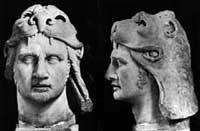The secret of King Mitridates
2001/03/01 Carton Virto, Eider - Elhuyar Zientzia
About 2,000 years ago King Mitridates of Ponto used a great trick to defeat his rivals. According to legend, Mitridates feared that enemies poison and to protect themselves from them took small doses of poison to develop their immunity to poisons. The technique worked and the name of the king is associated with antidotes for poisons.

The journal Science takes the legend from the poetic to the molecular and explains in an article the molecular bases of the resistance to the poisons of Mitridates. The Biological Research Institute of La Jolla (California) studies the defensive mechanism of the human body against poisons, and the journal Science tells its discoveries.
Hepatic spy
Humans are known to have in the liver a protective system composed of chemical lookouts for researchers and how they work more or less. When cellors detect potentially harmful chemicals, liver cells produce an enzyme called CYP3A, capable of destroying many compounds, including various toxins. However, it has not yet been clarified how exactly the system works.
It seems that a first receptor detects the toxin and orders its destruction to the chemical "police". But who is that recipient? Most scientists expected to find a large, specialized group of recipients, but it has not been so. According to studies of several groups, it is the only protein that makes this work. This protein has the ability to detect thousands of dangerous chemical compounds and gives you the order to attack the liver immediately after your detection.
The grass of Santiago gave them the way to reach these conclusions. Santiago's herb has a great reputation as an antidepressant, but in recent years it has been observed that it negatively interacts with certain medications such as certain anti-asthma, birth control pills or medications to avoid rejection of transplants. Whenever problems have been detected due to Santiago's wort, a lower blood drug level has been measured to patients. Therefore, many researchers believe that Santiago's herb activates the CYP3A enzyme.
Simple mechanism: simple mechanism
The researchers at Kalifonia have conducted tests to test the hypothesis and have obtained representative results faster than expected. In all trials with mice, it has been proven that Santiago's herb activates the PXR protein of cells that produces the CYP3A enzyme. Among the active compounds contained in the herb of Santiago, it seems that the molecule known as hyperforin is the only one responsible for this mechanism, at the same time that the protein PXR is the one that sets in motion the entire hepatic defense mechanism.
However, this last affirmation is not fully certifiable. In the journal Nature, a mechanism similar to the one described above has been announced. The process is very similar, but in this case the CAR protein and the CYP2B enzyme are involved. However, it can be advanced that the defense system against poisons is simpler than expected and if the hypothesis is fully confirmed, it will represent a great advance for the pharmacological.
Returning to the legend of Mitridates, why didn't he die poisoned? By ingestion of small doses of poison, which kept its defensive mechanism constant and once ingested high doses, the body could react quickly neutralizing the poison.

Gai honi buruzko eduki gehiago
Elhuyarrek garatutako teknologia




